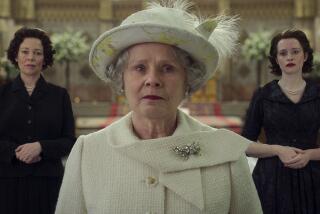With Royals, Much Divined From Little
- Share via
LONDON — Virtually every day since the reign of Mad King George III, and even during this incredible week, the Court Circular, the royal and tersely official printed equivalent of the White House daily press briefing, has reported the doings of the British royal family--after a fashion.
For last Sunday, it noted simply that the prince of Wales “learned this morning with great sadness of the death of Diana, princess of Wales. Divine service was later held in Crathie Parish Church.”
Yet, in the Daily Mail newspaper, the same Prince Charles is described in minute detail as walking sleeplessly through the heather at dawn, drinking gin martinis until all hours, tears coursing “down his ever-suntanned cheeks.”
How do they do that?
How does Britain’s press, tabloid and broadsheet, fill newspapers with stories about men and women who don’t give press conferences, hardly ever grant interviews--in fact, scarcely acknowledge the Fourth Estate at all?
And how, especially, on this of all stories, when the words that Britain’s royal family has issued on the death of Diana wouldn’t fill a Hallmark card?
Covering the royal beat is art and science, fiction and science fiction, shoe leather and a bit of snow job. It is Kremlinology--who stands where on the balcony. It is reading tea leaves and divining the future from the entrails of a sheep. And sometimes it is a tabloid cash transaction, a few pound notes in exchange for a few nuggets of information.
Come Saturday, the nation and the world will see seated in Westminster Abbey the largest turnout of royals in years--an appearance executed, as usual, in mime. And as always, the news stories will microtome every nuance of their mute conduct, looking for The Story.
Rhod Sharpe, who hosts a BBC radio program, knows the drill from when he covered the royals for a Scottish newspaper:
“Observe the body language. How still are the queen and [her husband, Prince Philip] standing? If Charles brings a finger up anywhere near the tip of his nose, it’ll be, ‘He’s wiping away a tear.’ ”
The clamor has been for the royals not only to grieve but also to be seen to grieve. It’s a quandary: If they don’t weep, they’re coldhearted, and if they do join in the national crying jag, they’ll be accused of shedding crocodile tears.
“They cannot win,” believes Judy Wade, royal correspondent for Hello!, a weekly magazine. “The slightest thing will be interpreted,” and the watching press will, she said, to enlist a Fleet Street cliche, “get out the old eggbeater and whip up the story.”
Sometimes the story souffle is on target. Sometimes not.
Diana and Charles crossed Canada together years ago without uttering a single on-the-record word to the press. And yet stories of the trip filled the papers daily.
In Canada, British royal reporters--the popular papers use the title “royal writer,” the up-market papers tend to use the more august “court correspondent”--resorted to crowd-seeding to get some news.
About half an hour ahead of the royals’ arrival, the reporters began working the crowd.
They suggested questions for tongue-tied fans. And after the royal couple left, the reporters returned to reap the harvest of their answers. (This technique netted a front-page story when Charles told one woman that he had called his infant son at home on his birthday and heard over the phone “lots of gurgles.”)
Although the monarch and the royal family ceased to be a political force in the 19th century, they still had to be about something. That something ended up being themselves--the best of Britain, the best of families.
How to accomplish that has stumped them ever since.
Leaks, sources paid and otherwise, and most recently, jockeying for good coverage, have changed the royal beat. Diana had been resorting more and more to contacting journalists to tell her side of the story in her battle with the palace and her ex-husband.
Royals are acutely aware of how they come across to the public but don’t always show that they are. At conflict is that history and sovereignty demand only that they be; modern media demand that they do.
Come Saturday, “what has to happen,” says Una-Mary Parker, a royal correspondent, “is that the royal family, who are not cold and unfeeling but brought up not to show it [emotion], must be seen to be grieving.”
“I don’t know whether the queen can do it,” Parker says. “The queen mother has always been able to. Prince Charles is incredibly sensitive--I’ve seen him cry at a concert, to very sad music.”
And Queen Elizabeth II “is terrified of emotion.”
The poker face serves a purpose, for when the royals do break down and weep, they--and not the people whose suffering they have come to observe--become the story.
More to Read
Sign up for Essential California
The most important California stories and recommendations in your inbox every morning.
You may occasionally receive promotional content from the Los Angeles Times.











